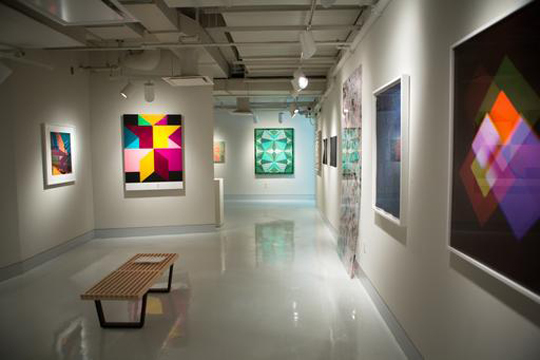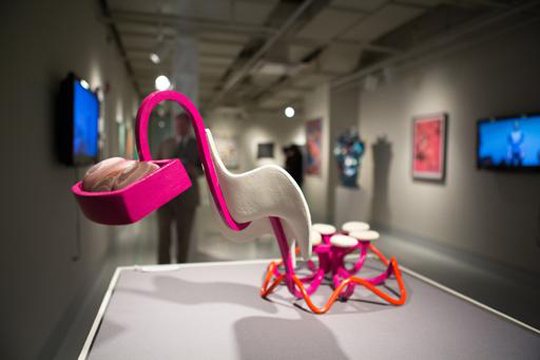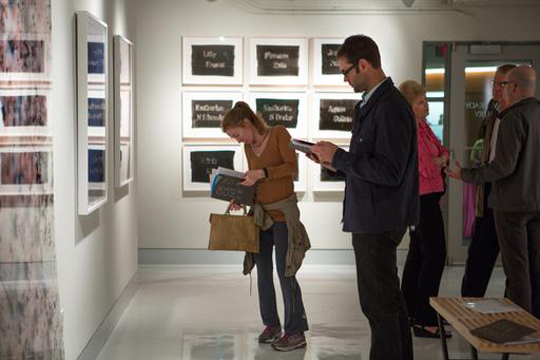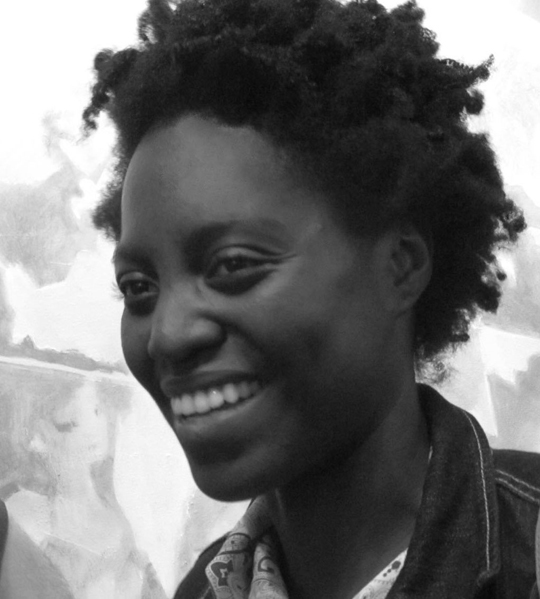Andrianna Campbell is a doctoral student in Art History at the CUNY Graduate Center. She is the recipient of the Dean K. Harrison fellowship from 2009 to 2012 and the prestigious Graduate Teaching Fellowship. She specializes in American art of the nineteenth and twentieth centuries. She earned a BFA in Printmaking with a concentration in Art History from the Rhode Island School of Design. As a student, she was awarded the Andrew Carnegie fellowship from the RISD museum. Subsequently, Andrianna was the Associate Curator at Forbes Inc. where she handled an international art collection. She currently teaches art history and a seminar about collaborative practice for the School of Art and Design History and Theory at Parsons The New School for Design, where she has been awarded 4 professional development grants, one of these in 2012, which allowed her to attend Documenta 13, contributing to the development of her recent exhibition.
Photograph by Janosch Delcker, 2011.
What current project are you at work on or have you just completed?
This year, I co-curated DECENTER, an exhibition that celebrates the anniversary of the 1913 Armory Show. On February 17, 2013, the exhibition opened at the Henry Street Settlement’s Abrons Arts Center. The space was built with funds raised by Marcel Duchamp and Milton Wolf Brown from a 1963 exhibit—a 50th anniversary reconstitution of the original Armory Show. Our exhibition has now traveled to the Luther W. Brady Art Gallery at The George Washington University where it will be on view until December 20, 2013.
 Decenter NY/DC: An Exhibition on the Centenary of the 1913 Armory Show at the Luther W. Brady Art Gallery, The George Washington University. Installation photographs credit of William Atkins.
Decenter NY/DC: An Exhibition on the Centenary of the 1913 Armory Show at the Luther W. Brady Art Gallery, The George Washington University. Installation photographs credit of William Atkins.
What inspired this project?
This project came about when Daniel S. Palmer and I were brainstorming what kind of show to put together for Abrons. We wanted to organize an exhibition that was specific to the space and celebrate the contribution of Henry Street Settlement to the artistic community. They had long held The Art Show at the Park Avenue Armory and held art classes in their Lower East Side community centers taught by the likes of Jackson Pollock.
After locating a signed Duchamp poster from the 1963 show in a closet at Abrons, we knew that we should organize an exhibit that celebrated the centenary of the 1913 Armory Show. With that in mind, an examination of abstraction in the contemporary moment seemed vital. Unlike other exhibitions held this year about abstraction, we examined changes in perception that have occurred over the last 100 years.
By considering an atemporal comparison between 1913 and 2013, we were able to evaluate abstraction today, which is so often filtered through our interactions with digitalization software and hardware. These digital technologies frame our way of seeing, navigating space, and archiving/ accessing information. By organizing an online and offline exhibit, we put forward a new curatorial model that embraces the advantages of exhibiting work in traditional and new spaces—the virtual, the real and their interstices. http://decenterarmory.com, our online exhibit, is constantly growing, as artists submit recommendations of online work from all over the world. This auto-curating model allowed us to decenter the New York art world and to propose multiple centers of art production.
 Decenter NY/DC: An Exhibition on the Centenary of the 1913 Armory Show at the Luther W. Brady Art Gallery, The George Washington University. Installation photographs credit of William Atkins.
Decenter NY/DC: An Exhibition on the Centenary of the 1913 Armory Show at the Luther W. Brady Art Gallery, The George Washington University. Installation photographs credit of William Atkins.
If you’re pursuing more than one project, are you finding connections between these pursuits, or do they feel separate?
Working on DECENTER at first seemed separate from my doctoral research on Norman Lewis and my seminar on contemporary collaborative practices, but it has managed to connect me with many scholars who have provided invaluable research for my writing. Marilyn Kushner at the New York Historical Society and Charles Duncan at the Richard Pousette-Dart Foundation have led me in new directions. Artists from the exhibition such as Cory Arcangel, Andrea Geyer, Ethan Greenbaum, Barbara Kasten, Andrew Kuo, Butt Johnson, John Newman, Gabriel Orozco and Sara VanDerBeek have also made their way into my curriculum because students have shown interest in their work.
 Decenter NY/DC: An Exhibition on the Centenary of the 1913 Armory Show at the Luther W. Brady Art Gallery, The George Washington University. Installation photographs credit of William Atkins.
Decenter NY/DC: An Exhibition on the Centenary of the 1913 Armory Show at the Luther W. Brady Art Gallery, The George Washington University. Installation photographs credit of William Atkins.
Do you find connections between these projects and your current, future, or recent work for Parsons?
Other projects seem to naturally cohere. My class at Parsons, Creativity and Cohabitation: The Marriage of Reason and Squalor was inspired by the few academic sources about collaborative practice in contemporary art. While working out the details of this class, I was asked to participate in a book about collaboration, which will be published by the Courtauld Institute of Art. Ileana Selejan and I are co-writing a chapter. My contribution focuses on photo-essays in traditional African-American publications such as Ebony and Color, which encouraged blacks to move to Mexico in the 1950s. Ms. Selejan is working on the photography of Cornel Capa in Guatemala in the 1950s, which were published in Life magazine. By presenting our work side-by-side, we hope to expand an understanding of what we call “concerned” photography in the post-War II period.
How have New York’s resources contributed to your current work?
New York was essential for organizing DECENTER because it is an exhibition about the legacy of the 1913 Armory Show, which was originally held here. In other ways, access to archives here is essential for scholars pursuing research.
Is this your first project of this kind? What unique challenges and discoveries are presenting themselves?
Before starting graduate work, I worked for the Forbes Collection next door to Parsons. Over the course of 5 years, I purchased work at auction for the Forbes family and curated exhibitions in one of the small galleries. The institutional support of such a large organization was invaluable. While working at Abrons, we had a very small team. This meant both Daniel and I worked on every aspect of the exhibit, but it also meant it was given all the academic rigor that we brought to our graduate work and teaching. Henry Street Settlement gave us carte blanche to install works such as David Kennedy Cutler’s 1 ton, 16ft tall piece that we commissioned for their front steps. They were with us every step of the way. Unlike the corporate environment, we were allowed to take risks. Although it was not my first exhibit, this made it feel like the first project of its kind with unique opportunities.
If this project is part of a long-term interest, how have you seen your work shift through time?
This project started as a consideration of networks. We were concerned with Alfred Barr Jr.’s diagrams of modern art and William Cheswick’s maps of the Internet and tying those to social media. We also thought of an exhibit about the brutalism of Abrons’ art space. It all seemed too dry for a primarily visual exhibit. My long-term research focuses on the abstraction of Norman Lewis and his ability to navigate connections in the African American community and the Abstract Expressionist one. So, I am fascinated by abstraction, networks of connections, technology, and the influence/import of collaborative projects between artists.
If you are at the culmination of a project, do you have plans for your next endeavors? What should we look out for from you in the future?
We just finished the catalog of our exhibit so the work for this exhibit has neared its end. Right now, I am working on an exhibition with Dimitrios Manousakis where we examine the work of artists in Athens, whose praxis is a response to a society in crisis. Their work is involved with the architectural and yet is ephemeral/transient. While the architectural turn from their counterparts in New York looks to the classical as inspiration to generate solid, austere and often totemic forms. I thought it would be great to examine the work of artists in Athens and New York that both engage as Epictetus says, “the faculties that are displayed in fashioning it.”



























